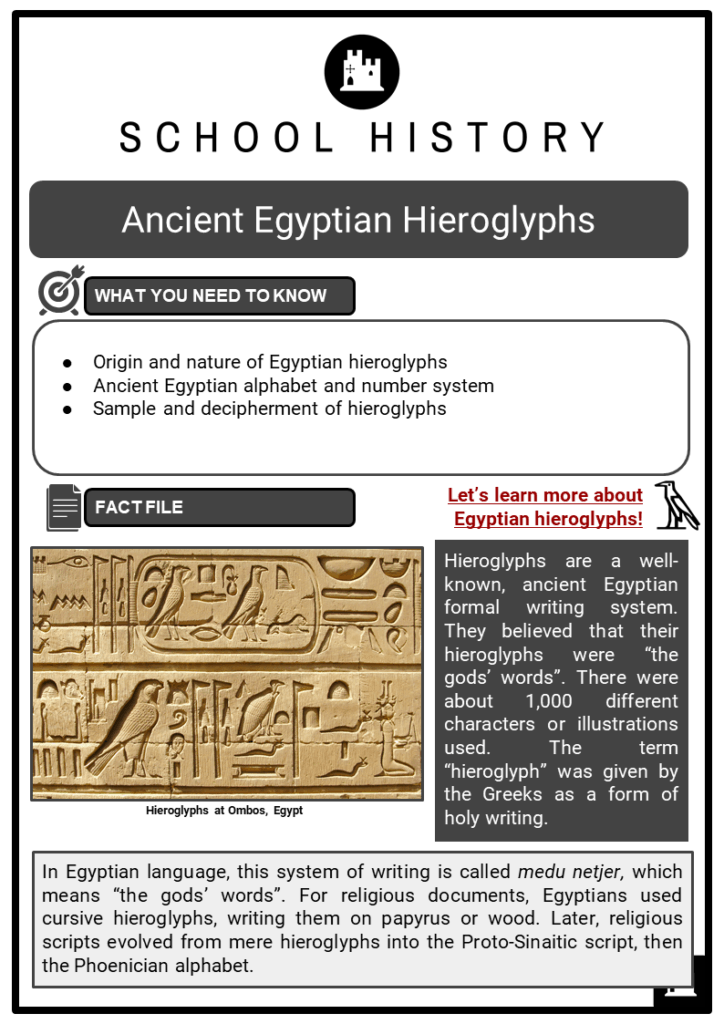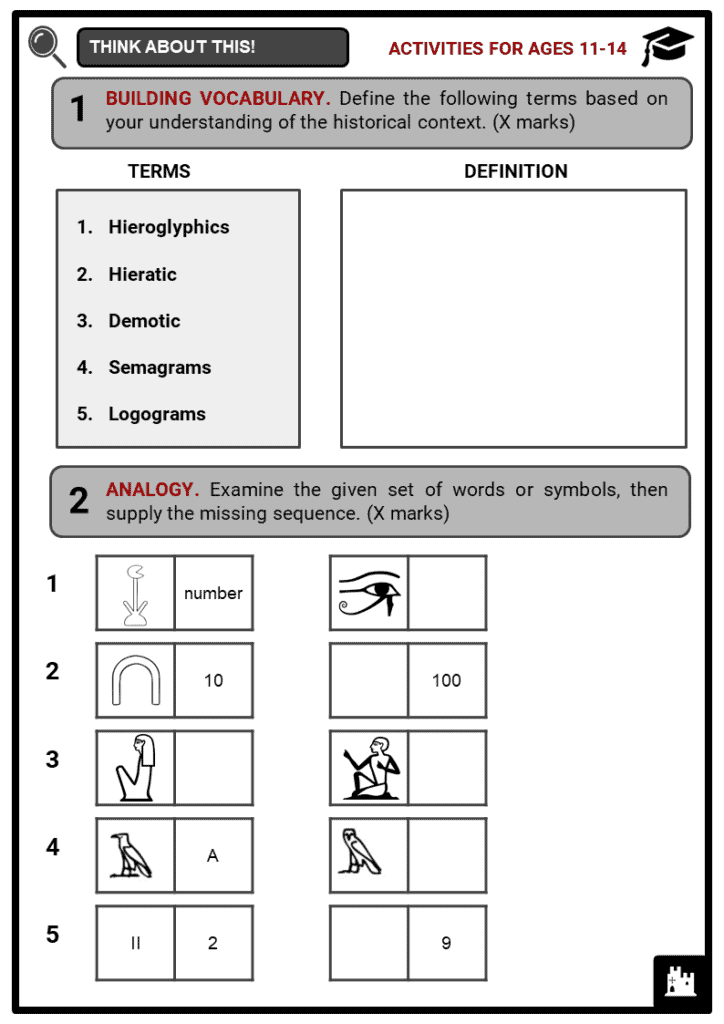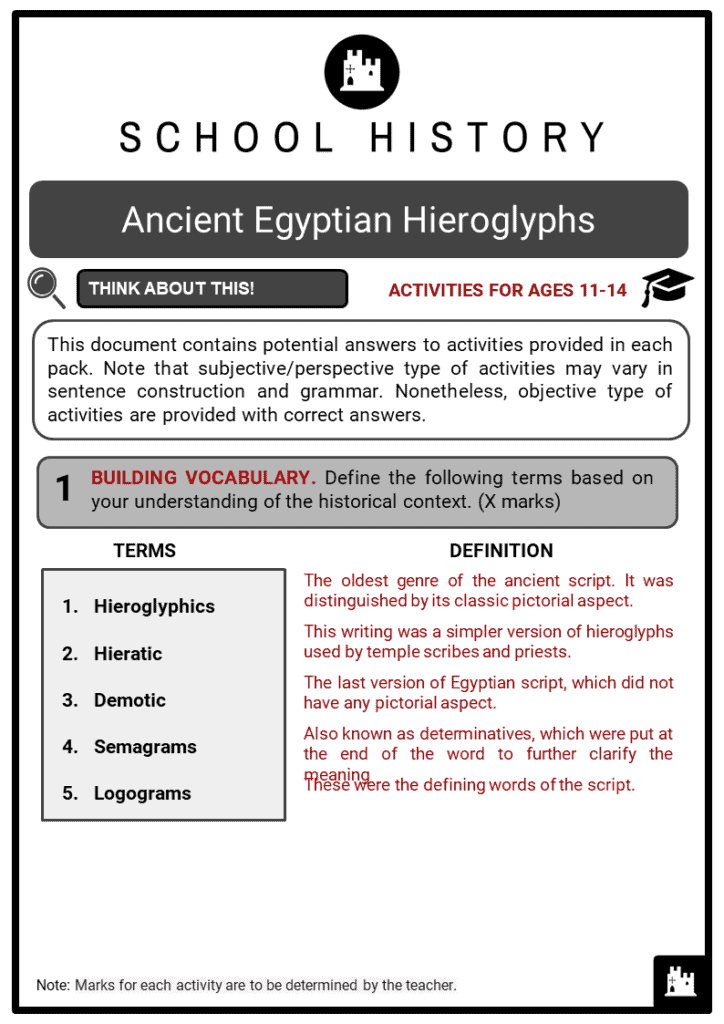Download Ancient Egyptian Hieroglyphs Worksheets
Do you want to save dozens of hours in time? Get your evenings and weekends back? Be able to teach Ancient Egyptian Hieroglyphs to your students?
Our worksheet bundle includes a fact file and printable worksheets and student activities. Perfect for both the classroom and homeschooling!
Table of Contents
Add a header to begin generating the table of contents
Summary
- Origin and nature of Egyptian hieroglyphs
- Ancient Egyptian alphabet and number system
- Sample and decipherment of hieroglyphs
Key Facts And Information
Let’s learn more about Egyptian hieroglyphs!
- Hieroglyphs are a well-known, ancient Egyptian formal writing system. They believed that their hieroglyphs were “the gods’ words”. There were about 1,000 different characters or illustrations used. The term “hieroglyph” was given by the Greeks as a form of holy writing.
- In Egyptian language, this system of writing is called medu netjer, which means “the gods’ words”. For religious documents, Egyptians used cursive hieroglyphs, writing them on papyrus or wood. Later, religious scripts evolved from mere hieroglyphs into the Proto-Sinaitic script, then the Phoenician alphabet.
Origin and nature of Egyptian hieroglyphs
- According to Egyptian mythology, Thoth (an Egyptian god of writing, magic, wisdom, and the moon) created writing to make Egyptians wiser. However, it was believed that Ra, the first god, disagreed with Thoth, arguing that hieroglyphs would make the memory of the human being weaker.
- Ra stated that men would depend on engraving information rather than memorizing it. Thoth did not agree with Ra’s opinion and gave a select number of Egyptians the techniques of writing. The scribes were the chosen people who had the knowledge and skill to use the gift of the gods.
- Scribes wrote and kept accounts of Egyptian society and government.
- The first hieroglyph sentence was written on a vessel found in the tomb of Seth-Peribsen at Umm el-Qa'ab. It is stated that the first hieroglyph sentence goes back to the 28th or 27th century BC. Historians say that there were nearly 800 hieroglyphs discovered in the tomb.
- A cemetery in Abydos was discovered that dated back to 3100 BC.
- Based on burial items, it is believed that a wealthy man, possibly a ruler was lying in the tomb.
Forms of Egyptian script
- The ancient Egyptian script included three major types of signs: logograms were defining words; phonograms were used for sounds; and determinatives, or semagrams, were put at the end of the word to further clarify its meaning.
- The heliographs are often followed by symbols describing words. Rarely, the phonetic complements can be placed at the beginning of words. Other times, they frame the word, meaning they are placed before and after it.
Types based on appearance
- Through time, Egyptian hieroglyphic scripts developed and produced varying versions. Egyptologist then categorised Egyptian writing into three types based on appearance.
Hieroglyphic
- Hieroglyphs are considered to be the oldest genre of the ancient script. It was distinguished by its classic pictorial aspect. This version of the script was found engraved on monuments and funerary burial materials.
Hieratic
- Hieratic inscriptions were supported by priests and temple scribes. This writing was a simpler version of hieroglyphs.
- This type of writing was derived from hieroglyphs, but it developed from a pictorial appearance into a more precise symbolic structure.
- It was written from right to left. It was used for personal papyrus documents, public matters, and paintings, but it was mostly used for religious purposes.
Demotic
- The demotic script did not have any pictorial aspect. This version of ancient writing was developed in the 7th century BC. It was called shekh shat, which meant “writing for documents”.
- Later, this version of writing replaced hieratic. Hieratic only endured to fulfil religious and funerary purposes. Demotic inscriptions were substantially different from the original hieroglyphics.
Egyptian Numbers
- Ancient Egyptians are believed to be the first human beings to practice scientific skills. They were good at medicine and mathematics, which is proven by their astonishing achievements in architecture and astronomy.
- 1 is a single stroke.
- 10 is a hobble for cattle.
- 100 is a coil of rope.
- 1,000 is a lotus plant.
- 10,000 is a finger.
- 100,000 is a tadpole or frog.
- 1,000,000 is a figure of a god with arms raised above his head.
- They also developed mathematical fractions, which were depicted by the eye of Horus.
- The right side of the eye = 182
- The pupil = 1/4
- The eyebrow = 1/8
- The left side of the eye = 1/16
- The curved tail = 1/32
- The teardrop = 1/64
- The use of the eye of Horus for determining fractions was said to be based on a myth about how Seth attacked Horus and tore his eye into pieces. It was Thoth who put back the pieces of Horus’ eye.
Egyptian Alphabet
- Compared to other ancient systems of writing, understanding hieroglyphics was more complicated since each symbol could represent a word, a sound, a concept, or a syllable. However, ancient Egyptian letters, like ours today, represent a sound.
- Their alphabet did not contain vowels, but they did use the letter ‘A’.
- Letters were written in horizontal rows or vertical columns and in both directions from right to left or vice versa. Thus, the translation of hieroglyphics was quite difficult.
- In most inscriptions, the ‘starting point’ is indicated by a human or animal figure facing the beginning of the line.
- Like spaces, punctuation such as commas and question marks were not used in Egyptian hieroglyphs.
- Cartouche is rarely used to name gods, i.e., Amun-Ra, the Sun god, and Cleopatra.
Sample and decipherment of hieroglyphs
- Coffin texts were inscribed for the purpose of guiding the deceased into the afterlife and to protect him from the dangers of this journey. Egyptians engraved scripts demonstrating maps of the heavens.
Coffin Text
- The coffin texts existed to simply pass information to following generations, further developing the idea of life after death.
- Egyptians engraved images in the bottom of the coffin, illustrating the life story of the deceased person.
- This was believed to help the dead remember who they were when they are born again in the afterlife.
- The coffin texts nearly resemble the pyramid texts. This hieroglyphic writing led ancient Egyptians to later write the work known as “The Egyptian Book of the Dead”. In the times of the New Kingdom, the Book of the Dead was engraved in one's tomb.
Pyramid Text
- Pyramid texts are known as the oldest of the Egyptian religious scripts. The hieroglyphs are carved on almost every inch of the interior of the chambers within the pyramids.
- The oldest texts go back to 2400–2300 BC. Pyramid texts are designed for pharaohs (kings), unlike coffin texts. A lot of pyramid text depicts Osiris, as he is the god of the afterlife.
- It served the same purpose as coffin text (as was mentioned above), only that these texts were engraved for kings.
- Most texts were called utterances, which were meant to be spoken out loud.
Rosetta Stone and Decipherment
- Napoleon Bonaparte assembled a good amount of researchers and went to Egypt in 1798 CE. The researchers copied several Egyptian texts and images. By 1799, the Rosetta Stone was found. This stone had a hieroglyphic text, and the same text was written in demotic and Greek.
- Despite the discovery, it was not until 1822 that Jean-François Champollion was able to decipher the cryptic script. He cracked the mystery with a comparison between the Greek script and the hieroglyphics.
- With the help of an obelisk from Philae, he studied every pictorial aspect of the ancient writing - the names, symbols, numbers.
- The names of Ptolemy and Cleopatra were written on the obelisk. Champollion came to the conclusion that the Egyptian hieroglyphs didn’t have alphabetic features, rather symbols conveying words, sounds, and ideas.
- It is believed that the inscription on the Rosetta Stone detailed a decree that was passed by a council of priests in relation to the rule of young Ptolemy V in 196 BC.
- Since 1802, under King George III, the Rosetta Stone has been on display in the British Museum.
- Prior to Champollion, English scholar Thomas Young deciphered cartouche as the name of Ptolemy. Moreover, he also figured that the symbols were meant to be read.
- With respect to the decipherment of the Rosetta Stone, the world was finally able to learn about ancient Egyptian civilization.
Materials used for hieroglyphs
- The hieroglyphs found in the first tomb were carved on small pieces of wood. Egyptians also carved on stone, metal, and ceramic. This manner of writing was found in royal tombs.
- Papyrus was used in ancient Egypt as a writing surface in the First Dynasty (3000-2890 BC). A blank roll that survived for thousands of years was discovered in the Tomb of Hemaka.
- Along with using papyrus, Egyptians also made use of wooden writing boards.
- Clay tablets in the Dakhla Oasis were found. These boards dated back to the late Old Kingdom, between 2686-2160 BC.
- They also wrote on leather, bones, and metal.
- Inscriptions have been discovered in the old city of Abydos, Egypt.
- Some of the symbols were numbers, and others were illustrations indicating the myths of their gods, while other details were depicting the pharaoh of that time. The inscriptions were written on pottery and stone vessels.
- Funerary stones have also been engraved by ancient Egyptians. The hieroglyphs found on those stones revealed the achievements of the pharaoh and his relationship with gods. These funerary stones were made to honour the deceased king.
- During the Ptolemaic Dynasty (332-30 BC) and the Roman Period (30 BC-395 AD) in Egypt, Egyptians were influenced by Greek and Roman cultures. Afterwards, Egyptians started to learn and practise the Greek language. After a long period of time, Egyptian hieroglyphs were replaced completely.






